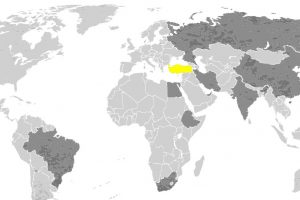by Dr. Afgan Valiyev*
On March 31, 1918, Armenians committed one of the most brutal massacres in history against Azerbaijanis in Baku, Guba, Shamakhi, Aghdash, Goychay, Karabakh, Zangezur, Nakhchivan and other regions of Azerbaijan. From March 30 to April 1, around 18,000 people lost their lives, more than 10,000 were wounded and maimed, and more than 15,000 were left homeless during the genocide. It is estimated that 15-20 thousand people were killed in Baku, 8229 in Zangezur (1), 7000 in Shamakhi and 6,000 in Guba during the genocide that continued until April 3. Massacres were also carried out in other regions such as Salyan, Navahi, Lankaran and Kurdemir, but the exact number of those killed is unknown. (2) In 1918, the number of Azerbaijanis subjected to the Armenian genocide is estimated at around 50,000. Azerbaijan and Baku did not recover from this massacre for a long time. This event was written in history as the March 31 massacre. In order to shed light on this tragedy, it is useful to first examine the course of historical events and the conditions of the period.
In 1917, after the collapse of Tsarism and the revolution that resulted in the Bolsheviks coming to power in Russia, the soldiers of the Tsarist army returning from the fronts gathered in Baku, Tbilisi and other major cities of the Caucasus. In Tbilisi, there was a military headquarters of 120 thousand people. Baku was overflowing with Russian soldiers returning from the Caucasus, Iran and the Western front. The Bolsheviks, aiming to draw the soldiers from the fronts and use them in the anti-Czarist revolutionary movement, did not offer the soldiers returning from the fronts to lay down their arms, but to fight against the anti-Bolshevik forces. Through propaganda, the Bolsheviks encouraged and provoked the soldiers returning from the fronts, especially those of Armenian and Armenian origin, to use weapons and force against the national forces and people striving for independence in the peoples under the sovereignty of Russia, which had been emptied of Tsarist rule. The Bolshevik Lenin government and its militants, including Armenian Stepan Shaumyan, Avakyan, Lalayef, Arakelyan and others, who seized power after the fall of tsarism in Russia, planned to extinguish the fire of independence through massacres in Baku in order to suffocate the independence movement in Azerbaijan.
During this period, national cadres dominated the local administrations in Azerbaijan, which were vacated by the tsarist regime, and while the representatives of the people elected through free elections were preparing to declare the independence of the Caucasus by establishing the South Caucasus confederation in the city of Tbilisi together with the elected deputies from other Caucasus regions, the Bolsheviks made efforts to prevent this event. On the other hand, those who were preparing for the March 31 genocide took the presence of national leaders Mehmet Emin Resulzade, Nesip Bey Yusufbeyli, Fath Ali Khan Hoyski and others in Tbilisi as an opportunity. The Bolsheviks, who aimed to have a say in Baku and intimidate the region, aimed to achieve this goal by using the Armenian-Azerbaijani animosity. In order to manage all these intrigues, Lenin sent the Armenian Stepan Shaumyan to the Caucasus as the Commissioner of the Council of People’s Commissars of the Caucasus.
We can briefly summarize the task given to Shaumyan as follows: “The Bolsheviks promised to protect the Armenian cause within the borders of Turkey and in return asked Armenians to support the enslavement of the Caucasus. The main goal of the Bolshevik provocation was the Sovietization of the Caucasus, which made plans by making efforts to sow discord, hatred, hatred and bloodshed among the Caucasian nations by gaining the favor of Armenians. Therefore, it tried to take advantage of the Armenian-Azerbaijani animosity. Alarmed by the rising nationalism and independence movement in Azerbaijan, the Bolsheviks saw the situation in Baku, where a large non-Turkish-Muslim population lived and where the city was overcrowded with unruly soldiers returning from the fronts, as an opportunity to realize their ugly ambitions.
Armenian soldiers in the Russian army and Armenians in Baku were armed, and under the leadership of the Dashnak terrorist organization, they went from house to house under the pretext of searching for weapons and supplies, killing Muslim men, capturing women and girls and raping them, bayoneting pregnant women and young children. It was in this spirit that the massacre of the Muslim-Turkish population of Baku, which lasted for 3 days from March 30 to April 1, 1918, began. During this massacre mosques, schools, hospitals, theaters, cultural monuments, houses and printing houses were set on fire. Armenian troops under the auspices of the Dashnaks, as well as armed Armenian units under Saakayan of the right-wing Es-er organization, participated in this massacre. As a reward, the Bolsheviks recruited Saakayan and Melik Yoljuyan of the Dashnaks as members of the Committee for the Defense of the Revolution. (3) Stepan Shaumyan, one of the leaders of the March massacre, who admitted that the March tragedy committed by the Bolsheviks together with the Armenians under the name of silencing the national independence movement led by the Musavatists in Azerbaijan was a national massacre, described the massacre as follows: “On the second day of the incident, the Dashnak Armenian military units, who agreed to participate in the war against the Musavatists, set out to create sedition and disorder in the city, to inflame the national massacre. They looted and killed the civilian population of the city, especially Azerbaijanis. With this, the Dashnaks wanted to degenerate the revolutionary forces, to give the class war between the proletariat and the anti-revolutionary forces in Baku the character of a national massacre” . (4)
On March 31, 1918, on the orders of the Revolutionary Defense Committee of the Bolsheviks against the civilian population, which was trying to organize for independence in Azerbaijan and whose weapons were collected in advance, an attack began with the help of artillery units, aircraft and the Caspian navy under the command of Russian and Armenian troops. The bombs dropped from airplanes and cannons fired from the Caspian Sea into the city caused death and destruction. The artillery shells fired from the Bolshevik armored trains destroyed the Surakhani district of Baku, almost the entire population was massacred, and the wounded and survivors were brutally massacred by the Armenian troops who arrived in the area. The same events took place in the center of Baku, Chemberekent, Bayıl, settlements on the road to Shamakhi, Goychay, Aghdash, Zangezur, Nakhchivan and Guba.
Mikoyan, a Bolshevik of Armenian descent who took an active part in the March 31 massacre and later held high positions in the Communist Party of the Soviet Union, felt the need to touch upon the national nature of the March tragedy in one of his articles and wrote the following lines; “Although the Bolsheviks tried to take measures to prevent the massacres and looting carried out by the Dashnaks, in any case, the subversive actions of the Dashnaks had a negative impact on the psychology of a certain part of the Azerbaijani laboring population of the city, causing them to distance themselves from Soviet rule”. (5)
Photographs taken by those who witnessed the March massacre, reports written by them, memoirs, statements of foreign representatives and consuls published together prove that one of the biggest massacres in the history of mankind took place in Azerbaijan on March 31, 1918. A foreigner named Kulka, who witnessed the March massacre, wrote in his memoirs: “They entered the neighborhoods inhabited only by Muslims and killed the inhabitants, slashed them with swords, riddled them with bayonets, set fire to houses, threw children into these fires and burned them alive, and put three or four days old suckling children on bayonets. Following the events, 87 bodies of Muslims were found buried in the ground. Their ears and noses had been torn off, their bellies ripped open and their limbs cut off. They tied the hair of the women they did not kill together and made them walk the streets naked and beat them with rifle butts…. They had no mercy for anyone. They had no mercy for children, and they had no mercy for old people. For example, in the house of Alizade Haji Amir, 80 old mothers, 70 and 60 old women were killed and 25 old fresh brides were nailed alive to the wall.” (6) The balance sheet of the bloody massacre against the Azerbaijani people was heavy. After the massacre of 18,000 Azerbaijanis, 5 Armenians, 3 Russians, 1 Georgian and only 2 Azerbaijanis served in the provisional Soviet government established in Baku.
On March 31, 1918, the Azerbaijani people built a martyrdom for the first martyrs of Azerbaijan’s independence in the most scenic place of Baku. On May 28, the government of the independent Republic of Azerbaijan perpetuated the memory of the first martyrs of independence by building a monument at the martyrdom. On April 27, 1920, Azerbaijan was occupied by the Bolsheviks. After 71 years under the rule of the Union of Soviet Socialist Republics (USSR), Azerbaijan declared its independence on October 18, 1991. By the decision of the 3rd President of Azerbaijan Heydar Aliyev on March 26, 1998, March 31 was declared as the Genocide Day of Azerbaijanis.
On December 30, 2009, President of the Republic of Azerbaijan Ilham Aliyev issued a decree on the establishment of the Genocide Memorial Complex in the city of Guba in order to inform the world community about the territorial claims and aggression, bloody crimes and genocide of Armenian nationalists against Azerbaijan, to preserve the national memory of future generations and to perpetuate the memory of the victims of genocide. On September 18, 2013, President of the Republic of Azerbaijan Ilham Aliyev and his wife Mehriban Aliyeva inaugurated the Genocide Memorial Complex in Guba. The Genocide Memorial, which also contains information about the victims of genocide in other regions, is visited by Azerbaijani dignitaries and people every year, especially on March 31.
[1] Azerbaycan Halk Cumhuriyeti Ansiklopedisi. İki ciltte, II cild, Bakü, 2005, s.461-462. [2] Vagif Abışov. Azerbaycanlıların Soykırımı (1917–1918 yıllar). [3] Z. İbrahimov, Sosyalist İnkılabı Uğrunda Azerbaycan Emekçilerinin Mücadilesi, Azerbaycan Devlet Neşriyatı, Bakü, 1957 s, 348 [4] Stepan Şaumyan, Statyi i Reçi v 1917 – 1918 (1917 – 1918 Yılındaki Makaleleri ve Nutukları), Moskova, s.251. [5] A. Mikoyan, Bakinskaya Organizatsiya Bolşevikov v 1917 – 1918 Godov (1917 – 1918 Bolşeviklerin Bakü Teşkilatı), Bakinskay Rabotçiy (Bakü İşçileri) gazetesi No.57, 14.3.1923, Bakü. [6] Mirza Bala Mehmetzade, “Kafkasya’da istiklal İlanının Kırkıncı Yıldönümü Münasibetile”, Dergi mecmuası, No, 12, Münih, 1958, ss, 14 – 16,*Dr. Afgan Valiyev is a sector manager at Azerbaijan Social Research Center.






